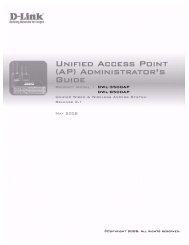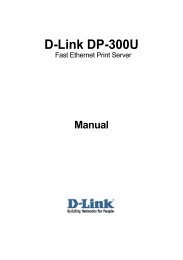Product Manual
Product Manual
Product Manual
Create successful ePaper yourself
Turn your PDF publications into a flip-book with our unique Google optimized e-Paper software.
DHCP<br />
<strong>Manual</strong><br />
Subnet Mask<br />
Default Gateway<br />
VLAN Name<br />
Admin State<br />
DES-3526 / DES-3526DC Fast Ethernet Layer 2 Switch<br />
The Switch will send out a DHCP broadcast request when it is powered up. The DHCP<br />
protocol allows IP addresses, network masks, and default gateways to be assigned by<br />
a DHCP server. If this option is set, the Switch will first look for a DHCP server to<br />
provide it with this information before using the default or previously entered settings.<br />
Allows the entry of an IP address, Subnet Mask, and a Default Gateway for the Switch.<br />
These fields should be of the form xxx.xxx.xxx.xxx, where each xxx is a number<br />
(represented in decimal form) between 0 and 255. This address should be a unique<br />
address on the network assigned for use by the network administrator.<br />
A Bitmask that determines the extent of the subnet that the Switch is on. Should be of<br />
the form xxx.xxx.xxx.xxx, where each xxx is a number (represented in decimal)<br />
between 0 and 255. The value should be 255.0.0.0 for a Class A network, 255.255.0.0<br />
for a Class B network, and 255.255.255.0 for a Class C network, but custom subnet<br />
masks are allowed.<br />
IP address that determines where packets with a destination address outside the<br />
current subnet should be sent. This is usually the address of a router or a host acting<br />
as an IP gateway. If your network is not part of an intranet, or you do not want the<br />
Switch to be accessible outside your local network, you can leave this field unchanged.<br />
This allows the entry of a VLAN Name from which a management station will be<br />
allowed to manage the Switch using TCP/IP (in-band via web manager or Telnet).<br />
Management stations that are on VLANs other than the one entered here will not be<br />
able to manage the Switch in-band unless their IP addresses are entered in the<br />
Security IP Management menu. If VLANs have not yet been configured for the Switch,<br />
the default VLAN contains all of the Switch's ports. There are no entries in the Security<br />
IP Management table, by default, so any management station that can connect to the<br />
Switch can access the Switch until a management VLAN is specified or Management<br />
Station IP Addresses are assigned.<br />
This allows the user the enable or disable the Admin State for the IP interface, by the<br />
using the pull-down menu. Disabling this feature will render all remote management<br />
inoperable, and thus the only way to configure the Switch will be to use the Console<br />
port for the Command Line Interface.<br />
Auto Config State When autoconfig is enabled, the Switch is instructed to get a configuration file via<br />
TFTP, and it becomes a DHCP client automatically. The configuration file will be<br />
loaded upon booting up. In order to use Auto Config, the DHCP server must be set up<br />
to deliver the TFTP server IP address and configuration file name information in the<br />
DHCP reply packet. The TFTP server must be running and have the requested<br />
configuration file stored in its base directory when the request is received from the<br />
Switch. Consult the DHCP server and/or TFTP server software instructions for<br />
information on loading a configuration file for use by a client. (Also see the section<br />
titled Upload Configuration for instructions on uploading a configuration to a TFTP<br />
server.<br />
If the Switch is unable to complete the autoconfiguration process the previously saved<br />
configuration file present in Switch memory will be loaded.<br />
Click Apply to let your changes take effect.<br />
Setting the Switch's IP Address using the Console Interface<br />
Each Switch must be assigned its own IP Address, which is used for communication with an SNMP<br />
network manager or other TCP/IP application (for example BOOTP, TFTP). The Switch's default IP<br />
address is 10.90.90.90. You can change the default Switch IP address to meet the specification of your<br />
networking address scheme.<br />
The IP address for the Switch must be set before it can be managed with the Web-based manager. The<br />
Switch IP address can be automatically set using BOOTP or DHCP protocols, in which case the actual<br />
28

















